Ijraset Journal For Research in Applied Science and Engineering Technology
- Home / Ijraset
- On This Page
- Abstract
- Introduction
- Conclusion
- References
- Copyright
Formulation and Evalaution of Flaxseeds Hair Gel
Authors: Vaishnavi B. Salunke, Pratiksha B. Holap, Shubhda S. Dube, Dr. Rajendra M. Kawade
DOI Link: https://doi.org/10.22214/ijraset.2024.63435
Certificate: View Certificate
Abstract
The remedies used to improve a person\'s look are called herbal cosmetics. Herbal hair gel eliminates dandruff and helps manage hair loss because it is made with natural components and herbal extracts. The purpose of this study was to create and assess a herbal hair gel using flax seed and aloe vera for its ability to promote hair development and fight dandruff. Vitamin E found in flax seed (Linum usitatissimum) promotes stronger follicles and better hair development. Aqueous extraction was used to create extracts from flax seed and aloe vera. Five distinct gel compositions with varied concentrations of Aloe vera and flax seed extracts were made and assessed. A number of characteristics, including color, scent, gel texture, clarity, pH, viscosity, spreadability, extrudability, and gelstability tests, strength, homogeneity, and in vitro antifungal activity. Out of the five formulations, F4 exhibited long-term stability without sacrificing its antifungal efficacy. Overall, the study\'s findings confirm that herbal hair gel made with aloe vera and other ingrediente remedies used to improve a person\'s look are called herbal cosmetics. Herbal hair gel eliminates dandruff and helps manage hair loss because it is made with natural components and herbal extracts. The purpose of this study was to create and assess a herbal hair gel using flax seed and aloe vera for its ability to promote hair development and fight dandruff. Vitamin E found in flax seed (Linum usitatissimum) promotes stronger follicles and better hair development. Aqueous extraction was used to create extracts from flax seed and aloe vera. Five distinct gel compositions with varied concentrations of Aloe vera and flax seed extracts were made and assessed. A number of characteristics, including color, scent, gel texture, clarity, pH, viscosity, spreadability, extrudability, and gelstability tests, strength, homogeneity, and in vitro antifungal activity. Out of the five formulations, F4 exhibited long-term stability without sacrificing its antifungal efficacy. Overall, the study\'s findings confirm that herbal hair gel made with aloe vera and other ingredientThe remedies used to improve a person\'s look are called herbal cosmetics. Herbal hair gel eliminates dandruff and helps manage hair loss because it is made with natural components and herbal extracts. The purpose of this study was to create and assess a herbal hair gel using flax seed and aloe vera for its ability to promote hair development and fight dandruff. Vitamin E found in flax seed (Linum usitatissimum) promotes stronger follicles and better hair development. Aqueous extraction was used to create extracts from flax seed and aloe vera. Five distinct gel compositions with varied concentrations of Aloe vera and flax seed extracts were made and assessed. A number of characteristics, including color, scent, gel texture, clarity, pH, viscosity, spreadability, extrudability, and gelstability tests, strength, homogeneity, and in vitro antifungal activity. Out of the five formulations, F4 exhibited long-term stability without sacrificing its antifungal efficacy. Overall, the study\'s findings confirm that herbal hair gel made with aloe vera and other ingredient.
Introduction
I. INTRODUCTION
Flaxseed, also called linseed, is becoming a prominent functional food ingredient due to its abundance of lignans, fiber, and omega-3 fatty acid, α-linolenic acid (ALA).Potential health benefits of flaxseed oil, fibers, and lignans include a lower risk of cancer, diabetes, atherosclerosis, cardiovascular disease, osteoporosis, autoimmune diseases, and neurological problems.2.In addition, flaxseed contains a wealth of fatty acids and antioxidants that aid in clearing the scalp of pollutants and dead cells. Applying flax seed gel to the scalp and hair as a moisturizer can assist to promote growth and strengthen already-existing hair...Topical formulations come in the form of oils, creams, ointments, pastes, and gels; among these, gels are becoming more and more well-liked these days due to their increased stability and ability to offer controlled release in comparison to other semisolid preparations. Gel formulations can offer improved absorption properties, increasing the drug's bioavailability.4. Gels are semisolid systems in which a high degree of physical or chemical cross-linking has been added to a three-dimensional polymeric matrix made of natural or synthetic gums, therefore confining a liquid phase.5.Gels are a relatively recent type of dosage forms made of higher amounts of aqueous hydroalcoholic liquids trapped in a network of colloidal solid particles, which can include organic polymers of natural or synthetic origin, inorganic substances like aluminum salts, or Anatomy of hair.
The hair root is located in the skin and reaches the skin's deeper layers. The hair follicle, a sheath of skin and connective tissue that encircles it, is joined to a sebaceous gland. The arrector pili, a small muscle that can produce hair, is connected to each hair follicle. The structure of the human hair follicle is fascinating, and there is still much to learn about the composition and development of hair. Three regions make up a hair follicle: the upper segment (infundibulum), the middle segment (isthmus), and the lowest segment (bulb and suprabulb). The erector pili muscle, also referred to as the arrector pili muscle, inserts into the lower section .
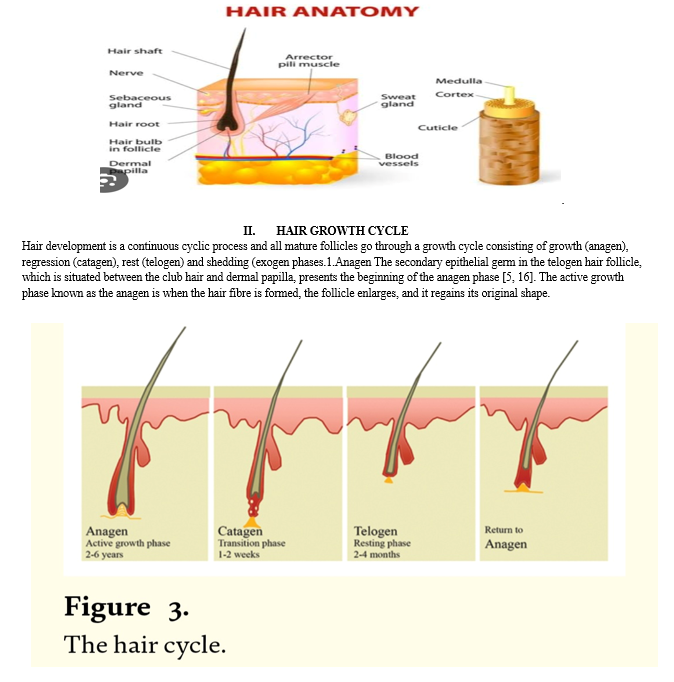
A. Anagen
Anagen is the stage in which 85–90% of scalp hairs are in. An example of the sixth phase of the anagen stage is given. Hair stem cells divide during anagen I–V, enclose the dermal papilla, grow to the skin's surface, and start to multiply hair shaft and IRS, respectively. The shape of the hair shaft then starts to take shape as hair matrix melanocytes start to produce colour; in anagen VI, the hair bulb and surrounding.
B. Catagen
Catagen After anagen, the matrix cells' mitotic activity decreases, and the follicle moves into the tightly regulated involutionary phase known as catagen. In humans, catagen lasts roughly two weeks, depending on the region and kind of follicle [37]. Apoptosis causes the distal portion of the follicle to involute during catagen, whereas the proximal portion of the hair shaft becomes keratinized and produces the club hair [16, 38]. There are eight steps in the catagen phase. The cessation of melanogenesis in the hair bulb is the initial indication of catagen. Cyclical alterations in apoptosis and differentiation are seen in neuroectodermal cell populations, mesenchyme, follicular epithelium, perifollicular vasculature, and neural systems. Nevertheless, any apoptosis that does occur occurs in the dermal papilla because suppressor.
C. Telogen
The time interval between the end of follicular regression and the beginning of the subsequent anagen phase is known as the telogen stage. Two to three months make up the telogen stage. Ten to fifteen percent of the hair is at the telogen stage. The hair shaft changes into club hair at the telogen stage, when it eventually sheds. The follicle stays in this stage until the hair germ, which is sensitive to signals from the dermal papilla that initiate anagen, begins to exhibit increased transcriptional and proliferative activity in late telogen, which causes anagen to begin [2,39]
D. Exogen
Though the patient views it as the most significant aspect of hair development, there is less interest in the mechanism underlying hair shedding. Human telogen hairs are frequently held onto from multiple follicular cycles, which implies that the anagen and exogen stages are separate processes. Exogen refers to this particular shedding phase since it is thought to be an active mechanism that occurs independently of telogen and anagen [16, 33].39].
E. Advantages
They have no unfavourable side effects and don't cause allergic reactions.
- They blend in effortlessly with skin and hair.
- Plant extracts have the ability to reduce the bulk properties of cosmetics while also having suitable pharmacological effects.
- Widely accessible and abundant in both diversity and quantity.
- Cost-effective and simple to manufacture.
F. Disadvantage
The effects of herbal medications are not as fast as those of allopathic dose forms.
- Long-term treatment is necessary.
- Sometimes it's hard to disguise taste and odour.
- The manufacturing process is intricate and time-consuming.
- No pharmacopoeia specifies any particular method or components that must be utilised in any
G. Flaxseed Applications
- Flaxseed for Hair Development Flaxseed gel is great for hair in many ways.
- Flaxseeds, being an abundant supplier of vitamin E and omega-3 fatty acids, help fortify hair and avert breakage.
- Flaxseeds can also guarantee hair health by reducing scalp inflammation.
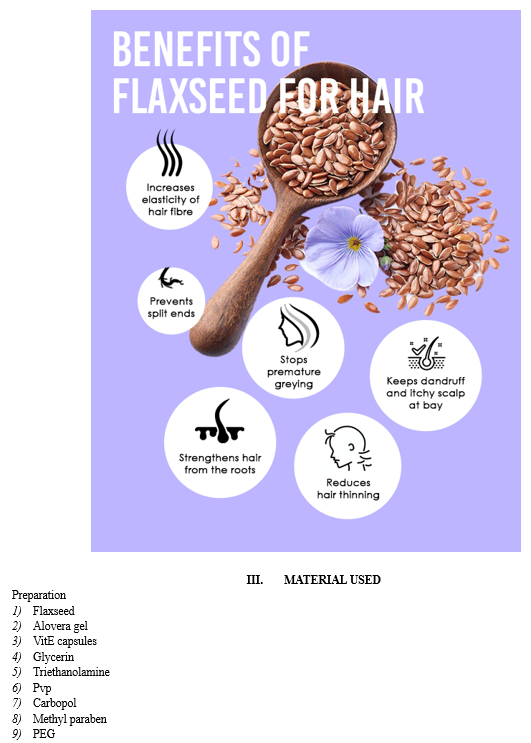
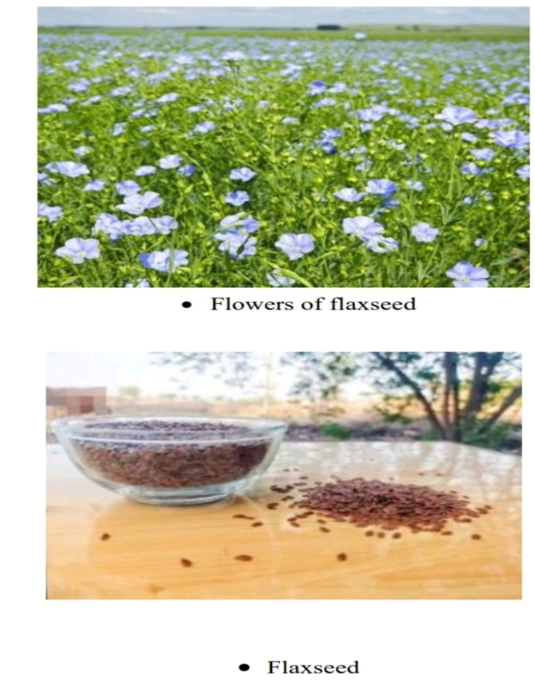
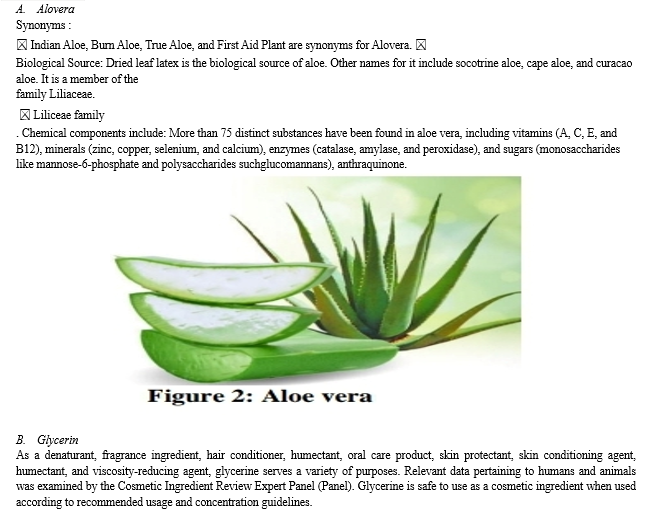

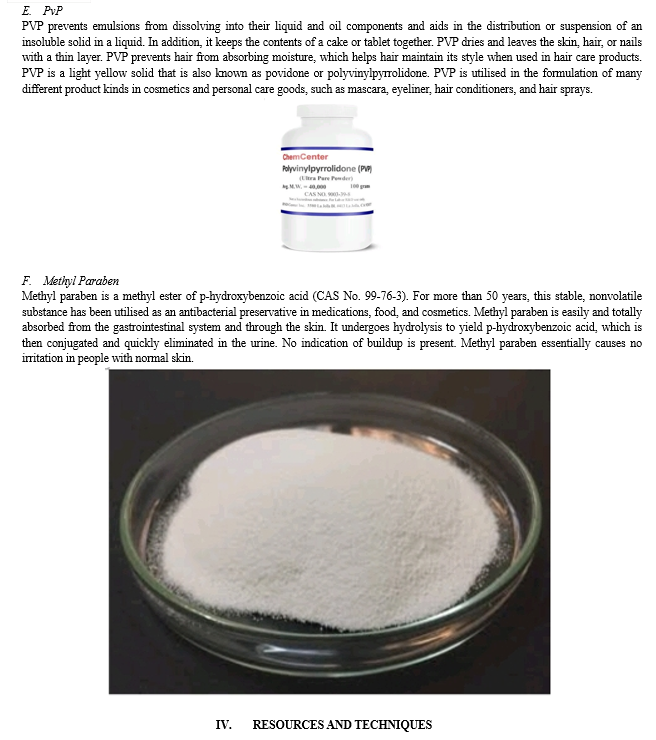
Materials Employed The flaxseeds were obtained from Bengaluru, India's nearby organic farm. The methyl paraben, PEG 200, glycerin, and carbopol 934 were obtained from SD Fine Chemicals in Mumbai, India. The remaining chemicals and reagents utilised were of analytical or laboratory quality.
V. METHODOLOGY
Hair gel base simulation A 250 ml beaker containing 35 ml of water was used to dissolve a weighed quantity of polyethylene glycol and a measured quantity of glycerin and methyl paraben. Next, a mechanical stirrer was used to quickly agitate the liquid. With constant stirring, a suitable amount of PVP and carbopol 934 were gradually added to the beaker containing the liquid mixture above. After that, a slow and constant stirring addition of triethnolamine (a gelling agent) was made until the gel structure was achieved. To maximise the carbopol concentration, five different gels were made (F1 to F5) with different carbopol concentrations of 0.5g, 1g, 1.5g, 2g, and 2.5g, respectively. It was discovered that the gels made with 0.5 and 1 grammes of carbopol 934 were extremely thin and liquid.
Until a thick mucilage was achieved, stir. After that, the mucilage was filtered through an appropriate sieve and kept at room temperature until needed again.8Using a carbopol gel foundation and a straightforward gel manufacturing procedure, five distinct herbal hair gel compositions were created. In a beaker, measured amounts of methyl paraben, glycerin, and polyethylene glycol were dissolved in roughly 35 millilitres of water. After that, a mechanical stirrer was used to agitate the liquid quickly. The beaker containing the liquid above was gradually filled with 2g of optimised carbopol 934 and PVP while being stirred. To create a gel structure, triethanolamine was then gradually added while being stirred constantly. Ultimately, different amounts of flaxseed aqueous extract (5%, 10%, 15%, 20%, and 25%) were added to carbopol gel and agitated for approximately one minute.
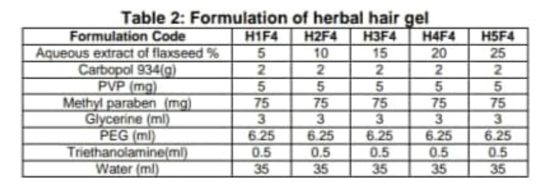
VI. EVALUATION OF HERBAL HAIR GEL
A. Formulations Physical Appearance
The physical appearance was visually checked for the appearance, colour and the feel on application of prepared hair gel formulations9. Results are as shown in table 3.
Homogeneity After the gel formulations have been set in the container, all developed gels were tested for homogeneity by visual inspection. They were tested for their appearance and presencelumpsflocculates or aggregates10 pH determination
B. PH
The pH of all hair gel formulations were determined by using the digital pH meter11One gram of gel was dissolved in 100 ml distilled water and stored for two hours. Electrodes were completely dipped into the hair gel formulations and pH was noted. The measurement of pH of each formulation was done in triplicate and average values.
C. Determination of Extrudability
Metal tubes that could collapse were filled with the hair gel mixtures. The material was forced through the tubes, and the formulations' extrudability was verified12. The weight in grammes needed to extrude a 0.5 cm gel ribbon in 10 seconds was used to assess the extrudability of the formulations. Table 3 displays the hair gel compositions' relative 489extrudability. determination of viscosity The viscosity was measured using a Brookfield viscometer. A sufficient amount of gel was added to each wide mouth jar independently. The gel in the jar should be high enough to allow the spindly to be dipped. The spindle was set to run at 2.5 RPM. The formulas' viscosities were noted. The results are as shown in
D. Plan of Work
- Organoletic Properties
The colour of herbal gel formulation were found to be dark white with translucent appearance which was found to be smooth on application. translucent appearance which was found to be smooth on application.
• Colour:-
• Odour:-
• Appearance:-
2. pH Determination
The pH of the herbal gel formulations ranged between 6.7 hair, indicating the compatibility of the herbal gel formulations with the hair.
3. Homogeneity
The developed gels were tested for homogeneity by visual inspectionfor appearance and presence of any lumps, flocculates or aggregates. The homogeneity was found to be good of herbal gel formulation.
4. Viscosity Determination
Viscosity is an important parameters for characterizing the gels as it effect the spreadability, extrudability and release of the drug. The viscosity of the formulations were found in the rangeof 1,50,232 to 1,52,876 cps. From the results it is clear that as the concentration of flaxseed extract increased from 5% to 20%theviscosity of the formulations also increased.
5. Spreadability
Spreadability plays an important role in patient compliance and help in uniform application of gel to the hair. A good gel takes less time to spread and will have high spreadability. The spreadability of formulated gel was decreased as the concentration of gelling agent increased.
VII. MATERIALS AND METHODS OF BASE
Materials Used:- Flaxseeds were procured from the local organic farm, Bengaluru, India. Carbopol 934, Methyl paraben and Sodium chloride and Reagents use were og either analytical or laboratory grade
Fig. 2.2 Mechanical Stirrer
The gels formed using 0.5gcarbopol 934 were found to be very thin that liquefied within 4 to 5 hours of preparation. The gel formed using 1g carbopol 934 gel formation was better tosomeextent but the problem of liquefaction after 24 hours was observed. The gel formulation containing 1.5g of carbopol 934 formed uniform and smooth gel that did not liquefy even after 24 hrs. With 2gcarbopol 934 the gel formation was better to some extent but problem was too thick tohandled.Whereas gel containing 2.5g carbopol 934 was too thick to be handled.Among the Five formulations, gel containing 1.5g carbopol 934.

VIII. RESULTS AND CONCLUSION
A. Physicalappearance
- Every herbal gel formulation, including H1F4, H2F4, H3F4, H4F4, and H5F4, was discovered to have a pale hue, a translucent appearance, and a smooth application.
- Homogeneity: The homogeneity of all the gels that were generated was examined visually to ensure that there were no lumps, flocculates, or aggregates present. For every formulation, the homogeneity was found to be satisfactory.
- PH determination: All of the herbal gel formulations had a pH between 6.7 and 7.3, which was suitable for the hair and showed that the formulations were compatible with the hair.
- Determination of extrudability: When extruded from a metallic collapsible tube, every formulation demonstrated good extrudability. H4F4 and H5F4 demonstrated superior extrudability compared to H1F4, H2F4, and H3F4. How to determine viscosity:
Conclusion
The flaxseed hair gel formulations provide a tremendous result in treatment of the scalp and strengthens the hair thereby inhibiting the hair loss. Flaxseed hair gel also prevents the hair from dandruff. Flaxseed also acts as an Anti-dandruff agentand involved in to reduce the generation of dandruff flakes. Flaxseed hair gel is prepared by simple boiling procedure, so it is less in cost and easy to handle. In flaxseed hair gel the aloe vera gel is also incorporated so it results in elimination of dandruff from scalp and protective for hair and provides healthy growth. The evaluation of the formulations was done on various parameters like physical appearance, pH, homogeneity, viscosity, spread ability, extrudability, and stability, In vitro evaluation study. The evaluation results shows that the flaxseed hair gel is compatible for hair and it having less side effects and these parameters show results in standard range. Hence, there is a further opportunity for pharmacological studies in
References
[1] Formulation and evaluation of flaxseed hair gel: a natural hair tamer d. Manjula, J. Josephine Leno Jenita , KB. Prema kumari , and Shanaz Banu , 8 March 2018 , www.ijrpc.com ISSN: 2231-2781,IJRPC 2018, 8(3), 487-491 . [2] Efficacy of a Nutritional Supplement, Standardized in Fatty Acids and Phytosterols, on Hair Loss and Hair Health in both Women and Men, Federica Zanzottera ,Gioia Bizzaro , Angela Michelotti ,Zanzottera et al., J Cosmo Trichol 2017, 3:2DOI: 10.4172/2471 . [3] Flaxseed: A Potential Medicinal Food, Charu katare, Sonali Saxena, Katare et al., J Nutr Food Sci 2012, 1http://dx.doi.org/10.4172/2155-9600.1000120. [4] Australian Journal of basic and Applied Sciences, 4(9): 4304-4312, 2010ISSN 1991-8178© 2010, INS Inet Publication Flax (Linum usitatissimum L.): Current Uses and Future Applications Amit J. Jhala and Linda M. Hall Department of Agricultural, Food and Nutritional Science, University of Alberta, Edmonton, T6G 2P5, AB, Canada. [5] Flax (Linum usitatissimum L.): Current Uses and Future Applications Amit J. Jhala and Linda M. Hall Department of Agricultural, Food and Nutritional Science, Australian Journal of basic and Applied Sciences, 4(9): 4304-4312, 2010ISSN 1991-8178© 2010, INSInet Publication. [6] Fatty acids composition and oil characteristics of linseed (Linum Usitatissimum L.) from Romania Journal of Agroalimentary Processes and Technologies 2012, 18 (2), 136-140. [7] Bioactive Components of Flaxseed and its Health Benefits January 2015International Journal of Pharmaceutical Sciences Review and Research 31(1):42-51. [8] Analysis of production of linseed (Linum usitatissimum L.) in the world, Popovic V., Sikora V., Tati? M., Filipovi? V., Terzi? D., Janji? S., Brdar Jokanovi? M., 2016, 20th International Eco-Conference®, 9th Internationational Eco-Conference® on Safe Food, 119-127. [9] Health Benefits and Nutritional Value of Flaxseed-a Review , Sadia chishty ,Monika ,Indian journal of applied research X 243 Volume : 6 | Issue : 1 | January 2016 | ISSN - 2249 -555X. [10] Physical and chemical properties of flaxseed , K.K. Singh , Devi Mrudula, October 2012International Agrophysics 26(4):423-426 DOI:10.2478/v10247-012-0060-4. [11] Extraction and purification of flaxseed proteins and studying their antibacterial activities , Journal of Plant Sciences 2014; 2(1): 70-76 Published online February 28, 2014 (http://www.sciencepublishinggroup.com/j/jps) doi: 10.11648/j.jps.20140201.21 [12] Flaxseed - A nutritional punch,Pravin M Ganorkar , January 2013International Food Research Journal 20(2):519. [13] How to Make Aloe Vera Gel Written by SaVanna Shoemaker, MS, RDN, LD on October 4, 2019 — Medically reviewed by Adda Bjarnadottir, MS, RDN (Ice). [14] Does Flaxseed Really Work for Beautiful Hair? Medically reviewed by Gerhard Whitworth, R.N. — Written by Kristeen Cherney on June 12, 2019. [15] Flaxseed – composition and its health benefits , Rajju Priya Soni , Mittu Katoch, Ashish Kumar and Pramod Verma [16] Sabarwal N, Varghese D, B rakish, K Anjali, J hashish, J sanjay,Developmentandevaluation of polyhedralformulations for hair growth activity: PHCOG J, 2009; 1(2):165- 170 . [17] Harding C.R., More A.E., Rogers J.S., Dandruff: a condition characterized by decreasing Level of Intercellular lipids in scalp Stratum Cornea and barriers function, Arch. Derma. R., 294; (2002); 221–230. [18] Ayyanar M, Ignacimuthu S, Medicinal plants used by the tribals of tirunelveli hills, Tamilnadu to treatpoisonous bites and skin diseases:Indian journal of traditional knowledge, 2005;4(3):229236. [19] Sabarwal N, Varghese D, B rakish, K Anjali, J hashish, J sanjay,Development andevaluation of polyhedralformulations for hair growth activity: PHCOG J, 2009; 1(2):165- 170. [20] Joshi P, Nanda D, Nainwal P and Saini P, Standardization of herbal ayurvedic oil formulation- Ksheer Bala Taila Asian Journal of Pharmaceutical Research and Development, 11;2013; 23- 126. [21] Fatima grace X, Rahul raj S, Shanmughanathan S, Chamundeeshwari, Preparation and evaluation ofpolyherbalhair oil: International journal of pharmaceutical chemistry and
Copyright
Copyright © 2024 Vaishnavi B. Salunke, Pratiksha B. Holap, Shubhda S. Dube, Dr. Rajendra M. Kawade. This is an open access article distributed under the Creative Commons Attribution License, which permits unrestricted use, distribution, and reproduction in any medium, provided the original work is properly cited.

Download Paper
Paper Id : IJRASET63435
Publish Date : 2024-06-24
ISSN : 2321-9653
Publisher Name : IJRASET
DOI Link : Click Here
 Submit Paper Online
Submit Paper Online

